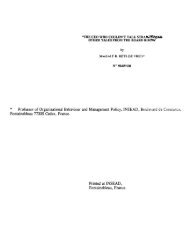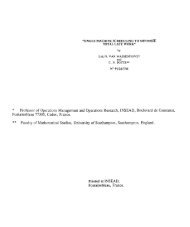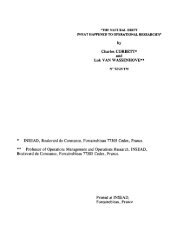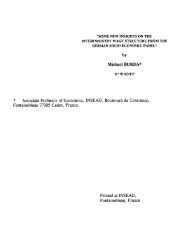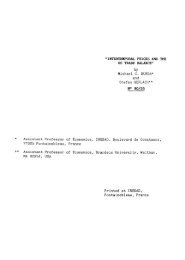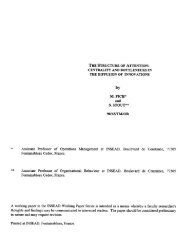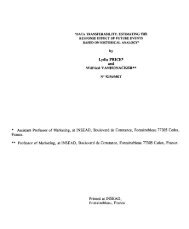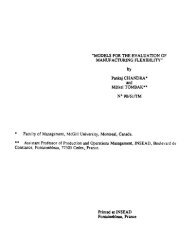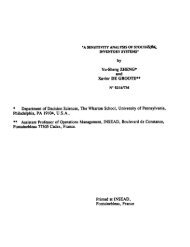* Assistant Professor of Operations Management at INSEAD ...
* Assistant Professor of Operations Management at INSEAD ...
* Assistant Professor of Operations Management at INSEAD ...
You also want an ePaper? Increase the reach of your titles
YUMPU automatically turns print PDFs into web optimized ePapers that Google loves.
<strong>of</strong> different firms, modeled as MI11111 queues, can only be explained by<br />
differences in the firms' capabilities. As long as the capabilities are the same,<br />
firms will behave similarly in the market and not differenti<strong>at</strong>e, even if the<br />
customer popul<strong>at</strong>ion has segments <strong>of</strong> differing characteristics (imp<strong>at</strong>ience and<br />
price sensitivity). This result holds, more generally, for MICA queues.<br />
In addition, the analysis in the present paper shows th<strong>at</strong> priv<strong>at</strong>e inform<strong>at</strong>ion<br />
on the side <strong>of</strong> the customers can cause the market equilibrium to break<br />
down. If the firms cannot observe the types (imp<strong>at</strong>ience and service requirement<br />
characteristics) <strong>of</strong> customers upon placing orders, customers may have<br />
the incentive to lie about their imp<strong>at</strong>ience in order to lower their total cost<br />
<strong>of</strong> service. This prevents the market from clearing. It is, however, possible<br />
for the firms to modify the contracts <strong>of</strong>fered to the customers to re-establish<br />
a functioning market, analogous to the case <strong>of</strong> an internal service facility<br />
with multiple customer types, which is presented by Mendelson and Whang<br />
(1990).<br />
For the case where the firms engage in quantity competition, the paper<br />
has constructed a contract in which the price per order depends on the actual<br />
service time in such a way th<strong>at</strong> the expected price is the market-established<br />
price and all customers reveal their true type. It is shown th<strong>at</strong> such a contract<br />
can always be found and is comp<strong>at</strong>ible both with the firms' equilibrium<br />
conditions and true revel<strong>at</strong>ion <strong>of</strong> type by the customers. More generally,<br />
firms modeled as M/G/1 queues can also construct an incentive comp<strong>at</strong>ible<br />
contract, if the second moments <strong>of</strong> all service time distributions are known<br />
to them.<br />
It is desirable to establish an analogous result for the case <strong>of</strong> price•competition,<br />
because price competition is more intuitive in some situ<strong>at</strong>ions, and<br />
because the two types <strong>of</strong> competition should be compared.<br />
Another area to be explored is the situ<strong>at</strong>ion when the proposed incentive<br />
comp<strong>at</strong>ible contract cannot be implemented, for example when regul<strong>at</strong>ion<br />
forbids identific<strong>at</strong>ion and differential tre<strong>at</strong>ment <strong>of</strong> customers. In this case,<br />
it is not clear whether firms will settle in an inefficient equilibrium with all<br />
customers being tre<strong>at</strong>ed the same, or whether now differenti<strong>at</strong>ion becomes a<br />
possible equilibrium, with firms dividing the market along segment lines.<br />
17



